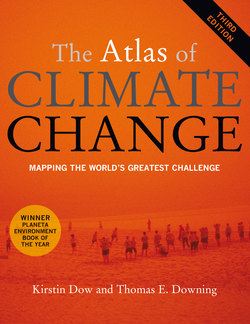Читать книгу The Atlas of Climate Change - Professor Kirstin Dow - Страница 13
Оглавлениеtechnologies offer great potential for greenhouse gas reduction as they currently account for less than 5 percent of global energy production. Greater efficiencies are possible in other manufacturing and power production systems as well. Interest in nuclear power has also risen, but its future role in addressing climate change issues is less certain. Concerns over safety and long-term storage of radioactive wastes remain, and it is not clear that its potential value as a response to climate change offers sufficiently strong justification to overcome other economic barriers. We have moved beyond the notion that installing energy-saving lightbulbs is all it takes: every bit helps, but all the bits need to be in play. Achieving needed reductions will involve adjustments to infrastructure and institutional practices, such as new building designs and training of architects and engineers. Yet, without changes in consumer demand, such as reducing the desire for ever larger homes and more powerful cars, these advances and opportunities could be fruitless. The necessary institutional innovations also depend on finance. Carbon trading is growing: markets such as the EU trading scheme and the Regional Greenhouse Gas Initiative in the USA are fully functioning. The level of trade is growing rapidly, but still represents a very small percentage of world carbon emissions. Pricing carbon in forests and terrestrial stores, as proposed in the REDD+ initiative, could transform local communities. Caution is warranted to ensure finance is secure and benefits those most dependent on forest resources. International parlance calls this the issue of leakage; empowerment, transparency and accountability are stronger watch-words to ensure corruption and control by the state does not overwhelm the global environmental benefits. Action will take new institutional strategies and forms of cooperation, and a willingness to deal with longer time frames in decision making. As scientists who for years have been studying the consequences of climate and other environmental changes on people and livelihoods, we believe climate change and its potential impacts are extremely serious issues. The required changes will involve us all deeply, but that social vision of a path to the future is not fully articulated. We seem to bounce between divided notions of fragmented communities preserving their own ideals and lifestyles and a global, shared vision of collective responsibility and action. Adaptation is an imperative, not a substitute for mitigation The commitment to warming is already in place – nothing we do now will alter global warming until the 2040s at best. Another two generations will be born, and the global population is likely to have added 2 billion people before our actions take effect. While the legacy of inaction and latent forcing of accumulated greenhouse gases are well-known features of climate change, the imperative to adapt with foresight and reduce the risks associated with the climate commitment has gained momentum only in the past decade or so. An odd feature of international negotiations has been that environmental campaigners resisted any mention of adaptation as a solution, fearing it would be seen as an alternative to mitigation and let the world off the hook of reducing emissions. This view restricted efforts to develop international adaptation funds and programmes. With growing understanding of the commitments and possible impacts, the IPCC fourth assessment clearly stated that adaptation and mitigation are policy complements, that is, they must both be pursued, and one does not substitute for inaction on the other. People, economies, and ecosystems are at serious risk from current climate patterns. Across large parts of Africa and Asia the timing and the abundance of rains determines whether crops will support households, or whether hungry people will need to search for alternative sources of food and income. Some coastal shorelines have limited protection from storms. Events of the past decade have reminded us that even the most advanced industrialized countries have an adaptation deficit, a lack of preparedness in the ability to deal with the present, much less the future. Those at risk are not randomly distributed; nor is risk accidental. Looking ahead, while there will be benefits for some, there will be severe consequences for others. Poverty is an enduring feature of how we organize our economies and societies. Those presently most vulnerable – poor people in marginal areas – are likely to suffer first. Nearly one person in four in developing countries lives in poverty, on less than $1.25 per day. These people often depend heavily on agriculture, fishing, and animal husbandry, or work in the urban informal economy in precarious housing, to maintain their livelihoods and hopes for better lives. With 2°C warming, millions more people, many of them among the poorest, are likely to be exposed to annual coastal flooding. Changing precipitation patterns, either wetter or drier, along with altered temperature, will affect crop productivity and availability of food and water for livestock. Climate changes may also facilitate the movement of human, plant, and animal diseases into areas where they were previously little known, and where doctors, veterinarians, agriculture extension specialists, and money for treatments are all in short supply. Not all serious climate impacts will be the direct result of local changes. The interconnectedness of the global economy is a major mechanism for transferring impacts from one region to another and among people. For instance, favorable growing conditions worldwide and a bumper crop might translate into lower prices for all
13
